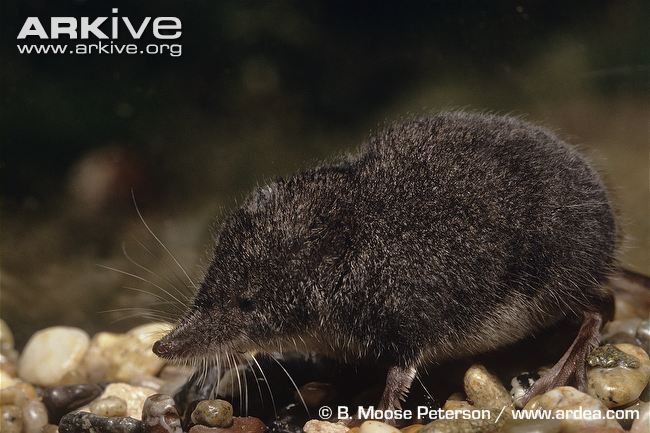Form and Function
Sorex pacificus, being a creature primarily active at nighttime,
has adapted a dark-colored coat to avoid predation during its
active hours from sunset to sunrise.
Another adaptation that the shrew has made is found in its
ability to hunt. Due to lack of light, the Pacific shrew preys
entirely based on smell and sound. The shrew is able to trail
insects entirely based on smell as they crawl across the
substrate. If the insect burrows into the soil, the shrew has no
problem quickly pursuing the insect and eventually attacking it.
Sorex pacificus does not prefer to burrow unless attacking or
hiding from predators in circumstances in which other protection
is unavailable. It can be observed constantly twitching its nose
and making twitching noises during hunting hours, possibly in an
attempt to smell or locate prey more efficiently. When insects
are flying, the Pacific shrew has been observed attacking
mid-air using it’s acute sense of hearing. However, it is much
more likely to wait until the prey has landed and pounce on the
insect’s wings (Maser and Hooven 1974). Because of the shrew’s
nocturnal habits, its vision is weak at best and is not relied
upon except in nest building.
The nests built by the Pacific shrew utilize a wide array of
materials from its surrounding habitat. This includes small
substrate such as decaying mosses, leaves, and minute pieces of
wood, which were carried in its mouth to the nesting area (Maser
and Hooven 1974). In this way, the structure of the mouth is
vital for not only ingestion of insects and small invertebrates,
but also for fundamental activities such as shelter building and
grooming.
Sorex pacificus appears to be a very neat mammal, as it is
observed to designate a specific area surrounding its nest for
relieving itself (Maser and Hooven 1974). Rather than simply
defecating in random areas around the environment, it can be
seen having a specific location set aside for these actions.
Another characteristic of the Pacific shrew that points towards
it being a cleanly creature is it’s grooming habits. It can be
seen grooming multiple times a day, taking up to two minutes per
grooming session. A very ornate grooming took place before
laying down to sleep, cleaning every part of the body from the
head to the tip of the tail, utilizing both the hind feet to
scratch and the mouth to lick clean. When it is time to lay down
and rest, the shrew will re-organize its nest before sleeping by
pushing and pulling elements of the nest with its mouth and
nose. It sleeps with its head curled underneath its body,
pointing towards its anus and tail tucked underneath the entire
body, and does not seem to sleep laying on its side. This rather
peculiar sleeping arrangement could be made in an attempt to
conserve body heat. By sleeping in this position, the shrew also
is able to awaken and move extremely rapidly if disturbed in its
sleep, possibly to escape prey (Maser and Hooven 1974).
A final adaptation that sets the Pacific shrew apart from its
shrew cousins is what happens after its prey is captured. Not
only does it have the incredible ability to seek, find, and attack prey based
entirely off sight and smell, but after the prey is attacked, it
is not always eaten! While a majority of prey is eaten
immediately after being killed, this shrew has adapted the
ability to instead carry and store some prey in its nest after
being attacked. Because the Pacific shrew is so unique in that
it is a nocturnal shrew, it also has acquired this unique
adaptation that makes it possible for the shrew to wake up
sparingly during the day and snack on the food it has already
stored in its nest if desired (Maser and Hooven 1974
Go Home
Continue on to Reproduction and Life History
